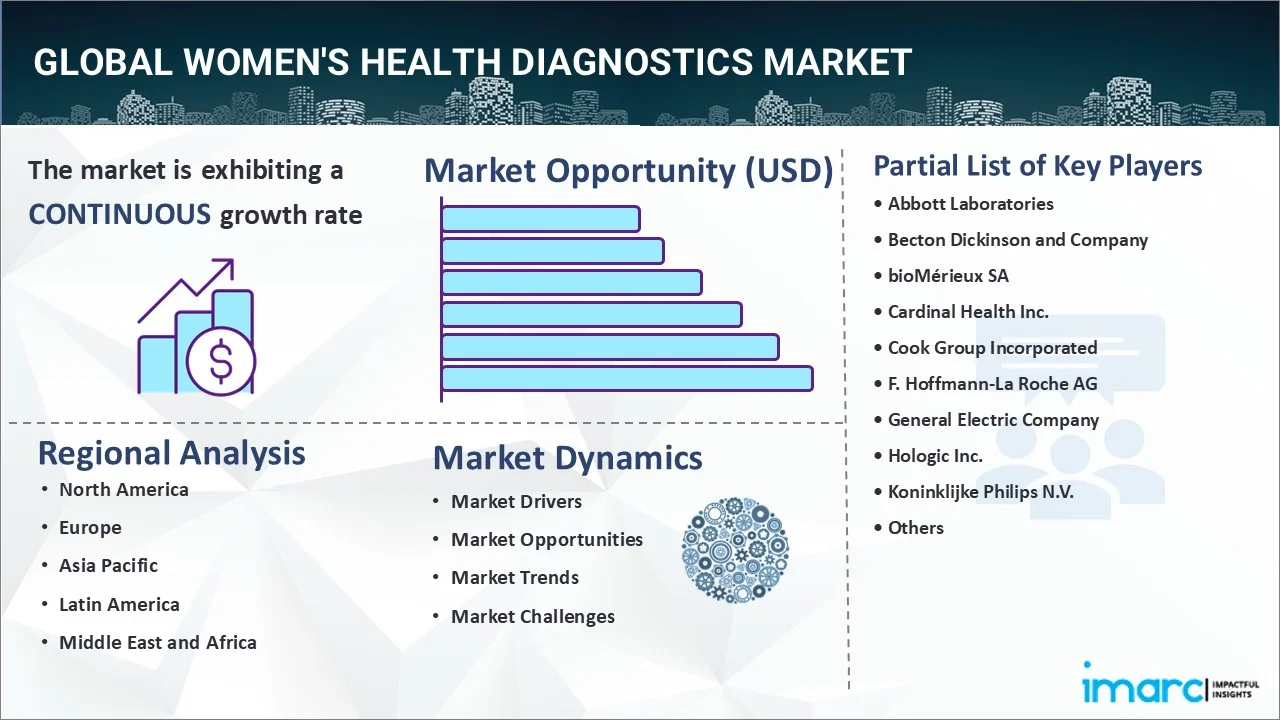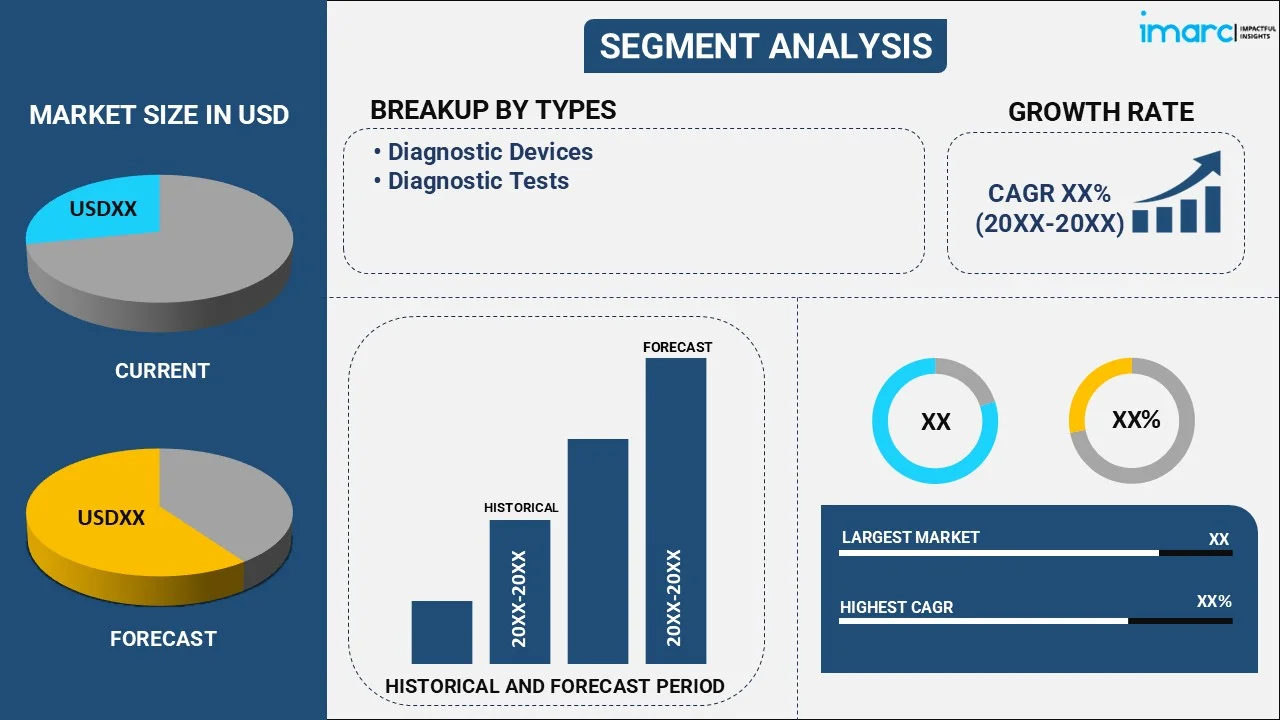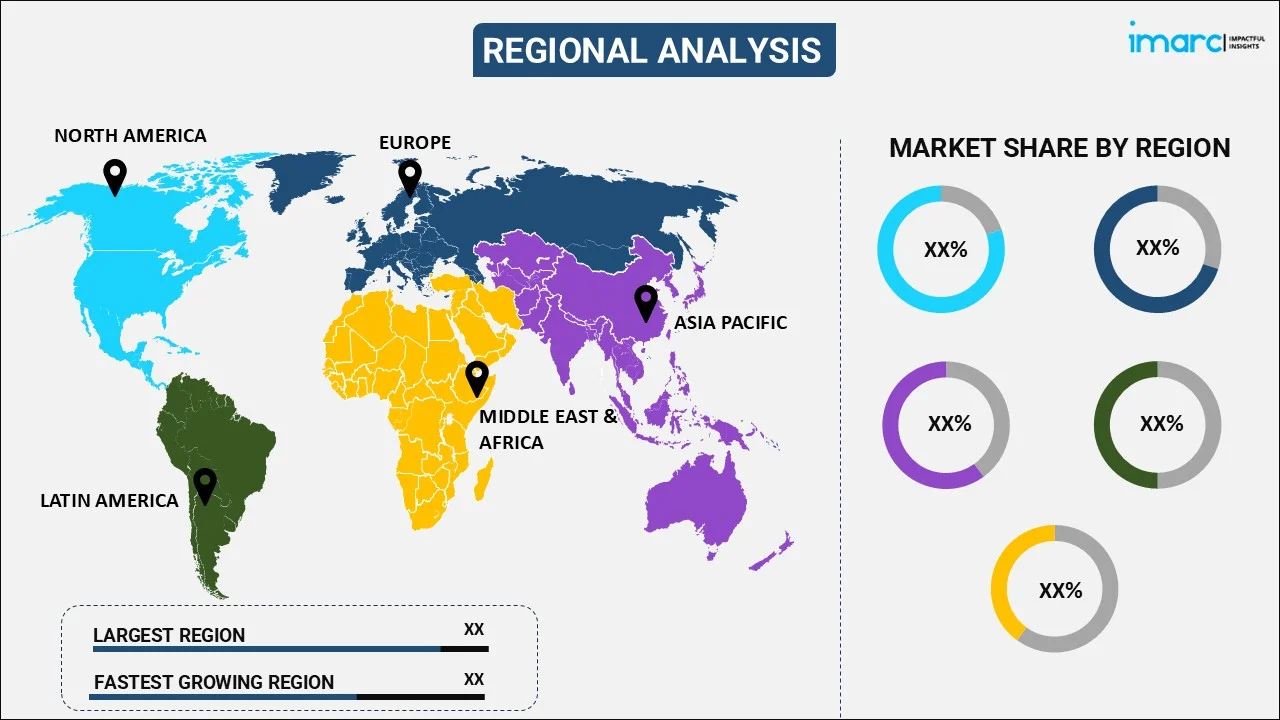
Women's Health Diagnostics Market Report by Type (Diagnostic Devices, Diagnostic Tests), Application (Breast Cancer, Infectious Disease Testing, Osteoporosis Testing, Pregnancy and Fertility Testing, Sexually Transmitted Disease Testing, and Others), End User (Hospital and Diagnostics Centers, Home Care), and Region 2025-2033
Women's Health Diagnostics Market Size:
The global women's health diagnostics market size reached USD 31.1 Billion in 2024. Looking forward, IMARC Group expects the market to reach USD 54.2 Billion by 2033, exhibiting a growth rate (CAGR) of 6.4% during 2025-2033. The market is propelled by the rising number of individuals diagnosed with chronic and lifestyle-related diseases, significant technological developments in diagnostic services, increasing awareness about women’s health through numerous campaigns and initiatives by the governments and public organizations, increasing acceptance rate of point-of-care diagnostics, and rapid growth in telemedicine and remote diagnostics industry.
|
Report Attribute
|
Key Statistics
|
|---|---|
|
Base Year
|
2024
|
|
Forecast Years
|
2025-2033
|
|
Historical Years
|
2019-2024
|
|
Market Size in 2024
|
USD 31.1 Billion |
|
Market Forecast in 2033
|
USD 54.2 Billion |
| Market Growth Rate (2025-2033) | 6.4% |
Women's Health Diagnostics Market Analysis:
- Major Market Drivers: Some of the major market drivers include the rising number of individuals diagnosed with chronic and lifestyle-related diseases, significant technological developments, and rising awareness and emphasis on the health of women.
- Key Market Trends: Rapid growth of the telemedicine and remote diagnostics market, increasing adoption of point-of-care diagnostics, and increasing number of research and development (R&D) activities are some key market trends of the industry.
- Geographical Trends: North America dominates the women’s health diagnostics industry due to its robust health infrastructure and cutting-edge competition within the industry. Europe holds second position on account of the rising number of individuals diagnosed with chronic diseases and increasing awareness about women’s health.
- Competitive Landscape: Abbott Laboratories, Becton Dickinson and Company, bioMérieux SA, Cardinal Health Inc., Cook Group Incorporated, F. Hoffmann-La Roche AG, General Electric Company, Hologic Inc., Koninklijke Philips N.V., Perkinelmer Inc., Quest Diagnostics Inc., Siemens AG and Thermo Fisher Scientific Inc., are among some of the key players in the women’s health diagnostics industry.
- Challenges and Opportunities: Women’s health diagnostics market recent opportunities include positioning in untapped markets and significant developments in personalized genomics and medicine. Whereas, challenges include expensive diagnostic tests and equipment and restricted access to healthcare facilities in rural regions.

Women's Health Diagnostics Market Trends:
Substantial Rise in the Number of Females Diagnosed with Chronic and Lifestyle-Related Disorders
One of the primary factors driving the market is the increasing prevalence of chronic and lifestyle-related diseases amongst women. These include, cervical cancer, osteoporosis, cardiovascular diseases, and breast cancer. According to the WORLD HEALTH ORGANIZATION (WHO), breast cancer is one of the leading causes of death among women globally. Approximately 2.3 million women were diagnosed with breast cancer and 6,70,000 succumbed to it globally, in the year 2022. The report also states that in nations with an exceptionally high Human Development Index (HDI), the chances of occurrence of breast cancer is relatively high as compared to nations with a lower HDI. This increasing prevalence of these diseases is leading to a higher women’s health diagnostics demand globally. One of the leading causes of these diseases is the sedentary lifestyles and poor dietary habits, which also lead to illnesses such as obesity and diabetes. Chronic illnesses usually require constant monitoring and management, thereby propelling the market growth. Other than this, the rising awareness about the importance of early detection is also playing a vital role.
Rising Government Initiatives
The rising government initiatives in order to spread awareness about the chronic illnesses prevalent amongst women, is creating a positive women’s health diagnostics market overview. The increased awareness and education associated with the distinctive health challenges faced by women in confluence with the importance of regular health screenings is driving the market. In order to achieve this, governments, non-profit, and public organizations organize campaigns focusing on the importance of early detection and preventive care. One of the most renowned campaigns for breast cancer is the BREAST CANCER AWARENESS MONTH, which runs through the entire month of October. This initiative was started in the year 1985 through a productive collaboration between the AMERICAN CANCER SOCIETY and IMPERIAL CHEMICAL INDUSTRIES, which is ever since a part of ASTRAZENECA, a major producer of breast cancer medications. The campaign increases awareness around the disease and also raises funds for its treatments, and research. The awareness month includes numerous social media campaigns, walking events, and races taking place across the globe.
Rising Acceptance of Point-of-Care Diagnostics
The increasing acceptance of point-of-care diagnostics is further driving the women’s health diagnostics market growth. The rising adoption of this type of diagnostics can be attributed to the advantage of conducing diagnostic tests nearby the patient, thereby offering immediate results and allowing faster clinical decision-making. This technique is majorly useful in cases where timely diagnosis can significantly impact treatment directions, such as in pregnancy-related complexities, cancer screenings, and sexually transmitted infections. According to a report published by the IMARC GROUP, the global point-of-care diagnostics market reached US$ 49.2 Billion in 2023, and is projected to reach US$ 99.5 Billion by 2032, reflecting a CAGR of 7.9% during 2024-2032. The report further mentioned numerous key players entering in partnerships in order to offer distinctive and dependable diagnostic solutions in order to transform the healthcare delivery. For instance, MOLBIO DIAGNOSTICS announced its collaboration with SIGTUPLE in the year 2023, for the development of next-generation AI-enabled movable devices for numerous routine and diagnostic tests.
Women's Health Diagnostics Industry Segmentation:
IMARC Group provides an analysis of the key trends in each segment of the market, along with forecasts at the global, regional, and country levels for 2025-2033. Our report has categorized the market based on type, application, and end user.
Breakup by Type:

- Diagnostic Devices
- Biopsy Device
- Imaging and Monitoring Devices
- Accessories and Consumables
- Diagnostic Tests
- Breast Cancer Testing
- PAP Smear and HPV Test
- Pregnancy Testing and Ovulation Testing
- Others
Diagnostic Devices accounts for the majority of the market share
The report has provided a detailed breakup and analysis of the market based on the type. This includes diagnostic devices (biopsy devices, imaging and monitoring devices, accessories and consumables) and diagnostic tests (breast cancer testing, PAP smear and HPV test, pregnancy testing and ovulation testing, and others). According to the report, diagnostic devices represented the largest segment.
According to the women’s health diagnostics forecast, diagnostic services dominate the market on account of the wide array of vital tests and screening possessed by them, which are important for early detection and management of numerous health conditions. Some of the most commonly available services include ultrasound, PAP smear tests, mammography, and blood tests which assist in the routine monitoring of specific conditions related to women’s health. Other than this, the rising number of females suffering with chronic illnesses is leading to a rise in the demand for regular health check up drives, thereby creating a positive women’s health diagnostics outlook. Moreover, the diagnostic services maintain a leading position within the industry also on account of the rising prevalence of the home diagnostic services. As per a market research report published by GITNUX, the global home diagnostics market is projected to reach USD 6.53 Billion by 201-2025.
Breakup by Application:
- Breast Cancer
- Infectious Disease Testing
- Osteoporosis Testing
- Pregnancy and Fertility Testing
- Sexually Transmitted Disease Testing
- Others
Infectious disease testing holds the largest share in the industry
A detailed breakup and analysis of the market based on the application have also been provided in the women’s health diagnostics report. This includes breast cancer, infectious disease testing, osteoporosis testing, pregnancy and fertility testing, sexually transmitted disease testing, and others. According to the report, infectious disease testing accounted for the largest market share.
Infectious disease testing dominates the market growth on account of the rising number of sexually-transmitted infections (STIs) and numerous other communicable diseases. According to the WORLD HEALTH ORGANIZATION (WHO), more than 1 million individuals are diagnosed with sexually transmitted diseases (ATIs) every single day, globally. Majority of these diagnosed cases are asymptomatic. In order to seamlessly and effectively manage these conditions, there is a crucial requirement for appropriate management and treatment solutions. Other than this, the rising awareness amongst individuals regarding these conditions is also driving the infectious disease testing market. According to GITNUX, the infectious disease testing market is exhibiting a CAGR of 7% during 2021-2026. Moreover, governments and public organizations across the globe are taking initiatives to promote regular testing for these diseases.
Breakup by End User:
- Hospital and Diagnostics Centers
- Home Care
Hospital and diagnostics centers represent the leading market segment
The report has provided a detailed breakup and analysis of the market based on the end user. This includes hospital and diagnostics centers and home care. According to the report, hospital and diagnostics centers represented the largest segment.
Hospital and diagnostic centers represent the largest segment on account of their holistic healthcare services, developed diagnostic technologies, and capability to handle a high volume of patients. These services provide customized expertise and infrastructure for precise and early detection of complicated health conditions which seek effective treatment planning beforehand. Other than this, the rising number of hospitals globally is also a significant factor driving the market. According to the AMERICAN HOSPITAL ASSOCITION, there are 6,120 hospitals in the United States. These centers are usually the first point of care for numerous females seeking medical aid, which further contributes positively to the women’s health diagnostic market revenue.
Breakup by Region:

- North America
- United States
- Canada
- Asia-Pacific
- China
- Japan
- India
- South Korea
- Australia
- Indonesia
- Others
- Europe
- Germany
- France
- United Kingdom
- Italy
- Spain
- Russia
- Others
- Latin America
- Brazil
- Mexico
- Others
- Middle East and Africa
North America leads the market, accounting for the largest women’s health diagnostics market share
The market research report has also provided a comprehensive analysis of all the major regional markets, which include North America (the United States and Canada); Asia Pacific (China, Japan, India, South Korea, Australia, Indonesia, and others); Europe (Germany, France, the United Kingdom, Italy, Spain, Russia, and others); Latin America (Brazil, Mexico, and others); and the Middle East and Africa. According to the report, North America accounted for the largest market share.
North America dominates the market on account of its robust healthcare infrastructure, presence of prominent key players and a significant rise in the healthcare expenditure across the United States. According to the AMERICAN MEDICAL ASSOCIATION (AMA), the health spending in the United States increased by 4.1% in 2022 to $4.4 Trillion or $13,493 per capita. The region particularly places a significant emphasis on early diagnosis and preventive care, in confluence with significant investment in research and development (R&D) activities thereby driving the market growth. Other factors driving the market include rising awareness campaigns, favorable reimbursement policies which further support the adoption of women’s health diagnostics recent developments.
Competitive Landscape:
- The market research report has also provided a comprehensive analysis of the competitive landscape in the market. Detailed profiles of all major companies have also been provided. Some of the major market players in the metal fiber industry include Abbott Laboratories, Becton Dickinson and Company, bioMérieux SA, Cardinal Health Inc., Cook Group Incorporated, F. Hoffmann-La Roche AG, General Electric Company, Hologic Inc., Koninklijke Philips N.V., Perkinelmer Inc., Quest Diagnostics Inc., Siemens AG and Thermo Fisher Scientific Inc.
(Please note that this is only a partial list of the key players, and the complete list is provided in the report.)
- Major women’s health diagnostics companies are significantly focusing on innovation and improving their product portfolios in order to improve diagnostic accuracy and efficiency. Additionally, they are also investing substantially in research and development (R&D) activities in order to launch advanced technologies including molecular diagnostics, AI-driven diagnostic tools, and next-generation sequencing. Prominent key players are also entering into strategic collaborations and acquisitions in order to enter untapped markets. For instance, in April 2023 QUEST DIAGNOSTICS and NEW YORK-PRESBYTERIAN announced that the former completes its acquisition fo selected assets of the laboratory services business of NEWYORK- PRESBYTERIAN. This strategic collaboration in meant to enable providers and patients to access good-quality, economical testing from a service menu that integrates the complementary strengths of both organizations.
Latest News:
- March 2023: VISBY MEDICAL received the U.S. FDA approval for its sexual health test. The novel diagnostic kit is a second-generation PCR that utilizes self-collected vaginal swabs to diagnose STIs such as trichomoniasis, gonorrhea, and chlamydia.
- March 2023: F.HOFFMANN-LA ROCHE LTD., announced its partnership with ELI LILLY AND COMPANY in order to offer assistance to the development of ELECSYS AMYLOIS PLASMA PANEL (EAPP) of ROCHE. The EAPP is a one-of-a kind blood test that aims to support the original diagnosis of Alzheimer’s disease.
Women’s Health Diagnostics Market Report Scope:
| Report Features | Details |
|---|---|
| Base Year of the Analysis | 2024 |
| Historical Period | 2019-2024 |
| Forecast Period | 2025-2033 |
| Units | Billion USD |
| Scope of the Report | Exploration of Historical Trends and Market Outlook, Industry Catalysts and Challenges, Segment-Wise Historical and Future Market Assessment:
|
| Types Covered |
|
| Applications Covered | Breast Cancer, Infectious Disease Testing, Osteoporosis Testing, Pregnancy and Fertility Testing, Sexually Transmitted Disease Testing, Others |
| End Users Covered | Hospital and Diagnostics Centers, Home Care |
| Regions Covered | Asia Pacific, Europe, North America, Latin America, Middle East and Africa |
| Countries Covered | United States, Canada, Germany, France, United Kingdom, Italy, Spain, Russia, China, Japan, India, South Korea, Australia, Indonesia, Brazil, Mexico |
| Companies Covered | Abbott Laboratories, Becton Dickinson and Company, bioMérieux SA, Cardinal Health Inc., Cook Group Incorporated, F. Hoffmann-La Roche AG, General Electric Company, Hologic Inc., Koninklijke Philips N.V., Perkinelmer Inc., Quest Diagnostics Inc., Siemens AG, Thermo Fisher Scientific Inc., etc. |
| Customization Scope | 10% Free Customization |
| Post-Sale Analyst Support | 10-12 Weeks |
| Delivery Format | PDF and Excel through Email (We can also provide the editable version of the report in PPT/Word format on special request) |
Key Benefits for Stakeholders:
- IMARC’s industry report offers a comprehensive quantitative analysis of various market segments, historical and current market trends, market forecasts, and dynamics of the women’s health diagnostics market from 2019-2033.
- The research report provides the latest information on the market drivers, challenges, and opportunities in the global women’s health diagnostics market.
- The study maps the leading, as well as the fastest-growing, regional markets. It further enables stakeholders to identify the key country-level markets within each region.
- Porter's five forces analysis assists stakeholders in assessing the impact of new entrants, competitive rivalry, supplier power, buyer power, and the threat of substitution. It helps stakeholders to analyze the level of competition within the women’s health diagnostics industry and its attractiveness.
- The competitive landscape allows stakeholders to understand their competitive environment and provides insight into the current positions of key players in the market.
Key Questions Answered in This Report
The global women’s health diagnostics market was valued at USD 31.1 Billion in 2024.
We expect the global women’s health diagnostics market to exhibit a CAGR of 6.4% during 2025-2033.
The rising popularity of women’s health diagnostics for efficient management of rare diseases and medical conditions in female patients is primarily driving the global women’s health diagnostics market.
The sudden outbreak of the COVID-19 pandemic had led to the postponement of elective women’s health diagnostics procedures across several nations to reduce the risk of the coronavirus infection upon hospital visits and interaction with healthcare professionals or medical equipment.
Based on the type, the global women’s health diagnostics market can be categorized into diagnostic devices and diagnostic tests. Currently, diagnostic devices account for the majority of the global market share.
Based on the application, the global women’s health diagnostics market has been segregated into breast cancer, infectious disease testing, osteoporosis testing, pregnancy and fertility testing, sexually transmitted disease testing, and others. Among these, infectious disease testing currently exhibits a clear dominance in the market.
Based on the end user, the global women’s health diagnostics market can be bifurcated into hospital and diagnostics centers and home care. Currently, hospital and diagnostics centers hold the largest market share.
On a regional level, the market has been classified into North America, Asia-Pacific, Europe, Latin America, and Middle East and Africa, where North America currently dominates the global market.
Some of the major players in the global women’s health diagnostics market include Abbott Laboratories, Becton Dickinson and Company, bioMérieux SA, Cardinal Health Inc., Cook Group Incorporated, F. Hoffmann-La Roche AG, General Electric Company, Hologic Inc., Koninklijke Philips N.V., Perkinelmer Inc., Quest Diagnostics Inc., Siemens AG, and Thermo Fisher Scientific Inc.
Need more help?
- Speak to our experienced analysts for insights on the current market scenarios.
- Include additional segments and countries to customize the report as per your requirement.
- Gain an unparalleled competitive advantage in your domain by understanding how to utilize the report and positively impacting your operations and revenue.
- For further assistance, please connect with our analysts.
 Inquire Before Buying
Inquire Before Buying
 Speak to an Analyst
Speak to an Analyst
 Request Brochure
Request Brochure
 Request Customization
Request Customization




.webp)




.webp)












